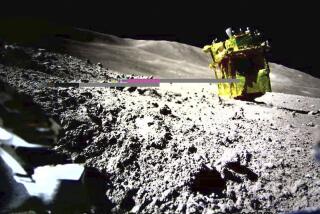Elusive Philae lander spotted on Rosetta’s comet one month before mission’s end
- Share via
Talk about timing!
Cameras aboard the European Space Agency’s Rosetta orbiter have spotted the elusive Philae lander tucked into a dark crack on the jagged surface of Comet 67-P/Churyumov-Gerasimenko, just weeks before the end of the mission.
On Sept. 30, the ESA plans to send the Rosetta orbiter to its final resting place on the surface of the comet in a controlled descent that will signal the end of an amazing and harrowing 12-year journey through space.
It’s a dramatic conclusion to a mission that has kept scientists and much of the public on the edge of their seats for more than a decade.
“We were beginning to think that Philae would remain lost forever,” said Patrick Martin, ESA’s Rosetta mission manager, in a statement. “It is incredible we have captured this at the final hour.”
The Philae lander was spotted in images taken on Friday, when the Rosetta orbiter came within 1.7 miles of the comet’s surface.
For the first time, scientists were able to clearly see the main body of the lander and two of its three legs.
Researchers said knowing the precise location of Philae is not just good for comet science, it’s also an emotional relief.
“It’s a huge psychological bonus to finally know where it is,” said Matt Taylor, ESA’s Rosetta project scientist. “And now we can redo some of the analysis from the lander and improve on it.”
The Rosetta orbiter blasted off from Earth on March 2, 2004, and spent the next 10 years traveling along a convoluted path through 4 billion miles of space to rendezvous with the speeding comet known as 67-P.
Fastened to Rosetta’s side throughout its long journey was the small Philae lander, designed to be the first manmade instrument to land on the surface of a comet and survive.
The orbiter released Philae on Nov. 2, 2014, just a few weeks after it arrived at the comet.
But the landing did not go as planned. Two harpoons designed to tether the lander to the comet failed to deploy properly, causing Philae to bounce. The lander flew for two hours before eventually settling in what was, until now, an unknown location.
Using radio signals sent between Rosetta and Philae, scientists were able to determine that the lander’s location was in a small area just a few hundred feet across on the smaller of the comet’s two lobes. However, the precise location continued to remain a mystery.
The Philae lander is just three feet wide, making it very difficult to spot on a comet with many features on a similar size scale.
“We really needed resolution that was only a few centimeters per pixel to see it,” Taylor said. “And that’s what we finally have.”
Over the last few months, Rosetta has been flying closer to the comet as its mission phase comes to an end, Taylor said. But since mid-August the orbiter has flown closer to the comet than ever before, making it possible, at last, to capture an unambiguous picture of the lander on the comet’s surface.
Although the mission is in its final few weeks, the data collection is not over yet. After a few more weeks of low-altitude crossings across the day side of the comet, Rosetta will change its orbit and take the final plunge on the comet’s surface at the end of September. It will continue to take measurements on the way down.
Do you love science? I do! Follow me @DeborahNetburn and “like” Los Angeles Times Science & Health on Facebook.
MORE IN SCIENCE
The hunt for Planet Nine reveals some strange, far-out objects
Juno reveals that Jupiter’s north pole is ‘like nothing we have seen or imagined’
Hot? You can cool down by suiting up in this high-tech fabric






